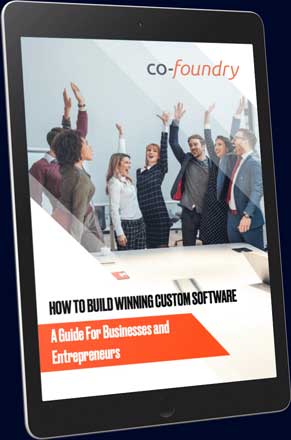Market Validation: How To Know If Your Software Will Be Used

When you custom-build your own software, you run the risk of spending a lot of money only for the project to fail. At Co-Foundry we work with people who want to develop exciting new software all the time.
Co-Foundry has successfully validated products for major national and international businesses. We were instrumental in doing this for clients such as SlikourOnLife music publication, The Stylista fashion blog, and the ThinkMoney financial site.
We’ve successfully launched software platforms that have processed hundreds of millions of dollars in value, and platforms that have millions of users.
Before any money is spent on development, we validate the market to make sure you don’t build something that’s destined to fail. Here’s how it works.
What Is Market Validation, Also Known As “Product-Market Fit”?
Validating the market, or ensuring what is known as “product-market fit”, means making sure there are people who will buy and use your software before you’ve even built it. You’ll be building something that you know people want because you’ve got the solution to a problem that needs solving.
In the words of successful Silicon Valley entrepreneur and investor, Marc Andreessen: “Product-market fit means being in a good market with a product that can satisfy that market.”
If market validation were an equation it would look something like this: Problem that needs solving + a solution that solves that problem + a big enough market that can’t live without your solution = product-market fit.
Why Is Market Validation So Important Before Starting Development Work On Your Software?
The reason early market validation is so important is simple really. If you develop software that nobody wants, then you won’t have buyers for your product, and the whole thing flops. Of course, if you’ve already invested a lot of time, money, and other resources in the project, most of this will go to waste. This could potentially be devastating for businesses, especially small ones and start-ups.
According to the technology insights platform, CBInsights, the top reason start-ups fail is lack of product-market fit. “Tackling problems that are interesting to solve rather than those that serve a market need was cited as the number one reason for failure, noted in 42% of cases,” the report states.
It goes on to quote start-ups that failed for this very reason. One of them was Treehouse Logic, a visual configurator platform company that set out to be ‘the SurveyMonkey of configurators’.
It told CBIngishts: “Start-ups fail when they are not solving a market problem. We were not solving a large enough problem that we could universally serve with a scalable solution. We had great technology, great data on shopping behavior, a great reputation as a thought leader, great expertise, great advisors, etc, but what we didn’t have was technology or a business model that solved a pain point in a scalable way.”
Making sure your idea resonates with your target market and will get traction is critical for success.
It also helps you get off the ground in the first place. If you have a product that the market demands, it makes it much easier to attract investors who want to be sure they’ll get a return on their investment.

So How Do You Validate An Idea?
This is the part where you get to be a scientist because validating an idea requires testing and experimentation.
Here’s one way to look at it. You want to make an erupting volcano for your child because you think they’d love it. You assume that adding bicarbonate of soda and vinegar to the volcano will cause the desired reaction. You don’t want to buy anything if you’re not actually sure it will work, so you do some research.
Once you’ve got the confirmation you need, you buy the correct ingredients. You excitedly make the volcano only to see that your child isn’t interested. You’ve wasted time, money, and disappointed your child. Later you find out that your child’s cousins would’ve loved the volcano and you could’ve waited for them to visit before going to so much effort.
Validating an idea is much the same. You need to take the assumptions that carry the most risk for your business or product, if they fail, and test whether they’re valid or not.
The two riskiest assumptions in the volcano analogy are that bicarb and vinegar will cause an eruption and that your child – the target market – wants to see an erupting volcano. The first assumption was validated by doing research. The second assumption wasn’t tested and as a result, you wasted time, effort, and money.
Discovering who your real customer is and whether there’s a demand for your product is an essential part of validating an idea.
There are many quick, easy, relatively low-cost ways to test assumptions. These include doing surveys, setting up a crowdfunding platform, making phone calls, sending emails, and building a landing page. You could also run A/B tests on different versions of an advertising campaign to see which one achieves better results.
It’s important to air your idea in the real world before you go ahead with development. Once you’ve seen whether your ideas are valid or not you can proceed with the ones that have potential, or pivot if necessary.
A Definite Demand In The Market
Part of the initial stages of testing your idea is making sure there’s definitely a demand for it. The most straightforward way to do this is by doing research.
Talk to other people in the industry or join relevant associations or groups in that field. Google also has great tools – some of them free – to make market research easy.
Do keyword searches related to your idea with free keyword research tools and Google trends. This will give you a good idea of how many times people have searched that keyword and what the search volume has been over a specified period of time.
If you’re very confident about your idea, you can even set up an inexpensive Google Adwords campaign and take pre-orders for your product. There are so many benefits to doing this. You’ll get a good idea of the demand for your product, you’ll get some income which you can use to develop it, and it acts as an initial marketing campaign to create hype around your product.
If you take this approach, the most important thing is to be honest with your customers. When they click through to buy your product, make sure they know that it still needs to be developed and give them an estimate of when they’ll receive it. If the product never materializes, make sure you’re able to refund them.
Competitors In the Market
As much as you want to ensure that you have product-market fit, it doesn’t help if you have many competitors already successfully servicing your target market. Doing competitor research during the conceptual stage of your project is vital to ensuring its success in the future.
Analyze your competition by seeing how many companies are offering the same or similar product (or service). You can use Google searches to do this. Once you’ve found competitors, see whether they have a strong social media following. You can also read reviews about their products and try to establish how long the businesses have been running.
Finding out that you have competition could be a good or a bad thing. Just enough competition can show you that there is a demand for your idea. But you will need to find a unique way to make your product stand out from all the others. On the other hand, too much competition could mean that the market is already over-served and that perhaps you should consider a different market, or change your idea.

Extensive User Testing Through Every Phase of The Project
Once you’ve validated your idea and you’re confident that there’s a market for it, it’s time to plan the build. The experimentation and testing don’t stop with the idea phase. You’ll be testing your product regularly throughout the planning and development stage to see how customers react to it and to make improvements based on their feedback.
This process of user testing throughout development is an agile software development methodology. Here, users’ needs are taken into account at each step. It’s all part of continuing to ensure that you have product-market fit throughout each phase of the project.
At Co-Foundry, the steps we take to do this are by project scoping, creating a proof of concept and prototyping, and then a minimum viable product (MVP).
Next, we’ll explain exactly how this works.
Proper Project Scoping Opens The Door To Product Market Fit
The first step in planning your build is to do proper project scoping. This creates a clear picture of the objectives of the project and exactly what it will take to achieve them. It’s akin to having an architect draw a proper plan of your house, which takes all your needs into account, before building starts.
Project scoping answers questions like how your product will look, who will buy it, and what you need to do to start making money soon. It identifies what the critical success factors are that have to be met in order for the project to succeed. Part of the scoping is to plan how to market and sell your product before it’s even been built.
It also covers the technical side of development. What will the users’ journey be when using your software? What frustrations will they face and how can you improve their journey?
Your plan will include which technology stack to use. This includes programming languages, frameworks, libraries, and software products that make up the backbone of your software. It takes into account which other apps or software your product should interface with to make it function optimally and attract or retain customers.

Proof Of Concept and Prototyping: Will Your Idea Fly?
Next, you want to be able to really visualize your project. You also want to have something to use to convince your manager, stakeholders, client, or investors that this project is something worth continuing with.
A proof of concept (POC) determines whether the software can be built in the real world. It verifies that certain features can be developed and are feasible. You can use the POC to test your design or software ideas and see what resources will be needed for the build.
Use the POC to identify potential technical and logistical issues and to gather feedback from your team and other stakeholders.
Once the POC is done, the really fun part begins. Now you can make a working wireframe prototype. This brings the essential design elements and content of your idea to life in a very basic build.
It won’t have a complete, coded back-end yet, but it will provide a visual and tangible representation of the solution. It can be tested and evaluated to determine workability and further validate the idea.
Minimum Viable Product
A Minimum viable product (MVP) is a fully functional solution that contains the most important feature or features needed for solving your target markets’ problem. While it’s not your final product, it’s got enough features that users can use it as if it is.
The aim is to build something that you can get to your customers as soon as possible so that they can start giving you feedback on it. Ideally, the people who use your MVP should be representative of your target market.
You’ll use their feedback to validate that you’re moving in the right direction. Insights on the features and functionality of your solution will be used to improve the next iterations, or versions, of it.
Basically, you’ll keep testing and improving the solution until you start receiving less and less negative feedback. This is all part of ensuring good product-market fit. Eventually, you’ll have a product that works so well that your customers can’t live without it!
Agile Software Development Builds The Product For The Market
This method of ensuring product-market fit is an example of how agile software development works.
Projects are built in stages to ensure flexibility. During every stage you tweak your product, each time coming one step closer to making it perfect.
Agile software development takes the users’ needs into account during each stage of development. By doing this you’re ensuring product-market fit throughout the project. But importantly, you’re also benefiting your business by making sure you have a good product with a good market for it.
This efficient process is cost-effective and contains less risk than other approaches to building software.

Final Thoughts and Final Test, Will People Buy It?
One of the best parts of this approach is it helps you gain customers before the product has even been built. How? Each time you run a Google Adwords campaign or send your MVP to users for testing you’re making important connections that you can leverage in the future.
Make sure that you’re asking potential customers for their email addresses so that you can let them know when the final product launches. If they used an early version of your product and loved it, they may well spread the word on your behalf.
Your marketing team should be involved in each step of the planning, development, and testing phases. The information learned during these processes can be extremely valuable to your marketing campaigns.
These are all ways you can build a market for yourself early on and relatively inexpensively before your final product has even launched. Once you’ve done your final testing, make sure you have an effective launch to ensure the continued success of your product.
Don’t Go It Alone
Co-Foundry has successfully validated products for major national and international businesses. We were instrumental in doing this for clients such as SlikourOnLife music publication, The Stylista fashion blog, and the ThinkMoney financial site.
We’ve successfully launched software platforms that have processed hundreds of millions of dollars in value, and platforms that have millions of users.
If you need help validating your product idea be sure to reach out to us. We’ll help you with a complete project scoping which includes market validation.

Want Help With Your Software Project?
Get Our Free Ebook: How to Build Winning Custom Software – A Guide For Businesses and Entrepreneurs
By subscribing, you agree to get emails from Co-Foundry. We’ll respect your privacy and you can unsubscribe at any time.






